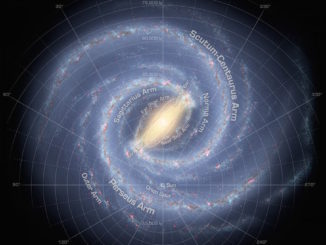
The intense emission arises from the hot environment of the black hole because electrons, moving at close to the speed of light in an environment of strong magnetic fields, radiate in the radio. The directed particle jets eventually collide with the ambient medium and convert much of their bulk energy of motion into shocks. The points of termination in the jet flow are seen as very hot spots, bright and compact structures. The hotspots can reverse the flow the jets back towards the black hole, and thereby generate additional turbulence and random motions. The characteristic temperature of a hot spot (or more accurately, the spectral dependence of the brightness versus wavelength) reveals the nature of the physical processes at work. Most known active radio galaxies have hotspots whose spectral dependence conforms well with the idea of termination shocks and reverse flows, but some very luminous radio galaxies do not conform.
The radio galaxy Cygnus A is the nearest and most powerful example of a double radio galaxy and as such is an archetype of this class. It is also one of the first objects discovered whose hotspots did not seem to conform with the conventional picture, and for decades astronomers have debated the possible reasons. The limited ability of long wavelength (low frequency) radio telescopes to resolve the small sizes of the hotspots was one complicating factor. CfA astronomers Reinout van Weeren and Gianni Bernardi (now at the Square kilometre Array in South Africa) were part of a large team who used the Low Frequency Array (“LOFAR“) radio telescope to obtain high spatial resolution images of the hotspots in Cygnus A. Their results provide the first direct evidence that the spectral shape difference previously inferred is real. The scientists are presenting a detailed analysis in a separate paper, but in this paper the basic results indicate that some other process besides shock activity must be involved; the team suggests absorption of the radiation by intervening local material could be part of the final picture.



